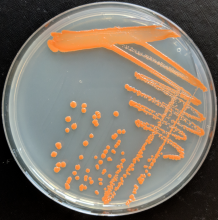Host Basics-Gordonia rubripertincta

An Introduction to Your Host Bacteria: Gordonia rubripertincta
As a network of researchers, SEA-PHAGES explores the genetic diversity and relationships of populations of bacteriophages that infect Actinobacteria, incluidng the bacterium Gordonia rubripertincta. There are many different strains of Gordonia rubripertincta (isolated from different samples). The Gordonia rubripertincta strain widely used in SEA-PHAGES is called Gordonia rubripertincta B16540-SEA, and is made available to you via the USDA culture collection. If you intend to isolate phages using this bacterium, then this will be your ‘host’ for phage isolation.
G. rubripertincta is one of over 19 species that make up the genus Gordonia, classified within the phylum Actinobacteria. G. rubripertincta is a gram-positive soil organism and, like its relatives, is well equipped to breakdown various hydrocarbons. This ability makes Gordonia attractive bacteria for use in bioremediation (i. e. the breakdown of pollutants) and in industrial biotechnology. For example, Gordonia sp. MTCC 4818 is able to breakdown phthalic acid esters, which can act as hormones that disrupt normal body function. Another Gordonia species, CYSK-1, is able to remove sulfur from fossil fuels, which will allow for the production of cleaner fuels, such as ultra-low-sulfur diesel.
G. rubripertincta will grow and divide on many nutrient-rich media. In your research, you will grow G. rubripertincta on PYCa media and at 30 ˚C. Under these conditions G. rubripertincta grows rapidly, and it typically takes about 2 - 3 days for an individual cell to form a colony on an agar plate. However, when preparing a bacterial lawn, you can start by adding many bacterial cells (e. g.
107 or more) so that a lush lawn grows within 1 – 2 days. For reproducibility of experiments, it is important that cultures used for a given set of experiments be prepared at the same temperature.
G. rubripertincta colonies are tan to orange in color, glossy and smooth in texture, and round or slighly irregular in shape (Figure 4.0-4). When incubated for prolonged periods, the color of the colonies intensifies to a brilliant orange. A liquid culture of G. rubripertincta inoculated from a single colony will take 2 – 3 days to form a saturated liquid culture, exhibiting a tan to orange color. The strain you will work with, G. rubripertincta B16540-SEA, is not inhibited by the antifungal
cyclohexamide, or the antibiotic carbenicillin at low concentrations. Therefore, this can be added to the growth media to prevent other microorganisms from growing in your cultures.
On average, 20 % of attempts to isolate phage from soil by enrichment with G. rubripertincta yield phage.
 |
|---|
Figure 4.0-4. Gordonia rubripertincta growing on an agar plate. |
If you are using this bacterium as your host for phage isolation, refer back to the list below for the specific growth and culture requirements for your experiments.
Growth media: PYCa, supplemented with Tween80 as necessary (see instructions for culturing bacteria that require Tween80)
Growth temperature: 30 ˚C
Antimicrobials: cycloheximide (10 μg/ml), carbenicillin (not recommended)
Phage Buffer: 10 mM Tris (pH 7.5), 10 mM MgSO4, 68 mM NaCl, 1 mM CaCl2, (10% glycerol, optional)
Restriction Enzymes: BamHI, HaeIII, HindIII, MseI, NspI, and SacII.
Note: Isoschizomers, which are different restriction enzymes that recognize the same DNA sequence, may be used in place of any of the enzymes listed above.